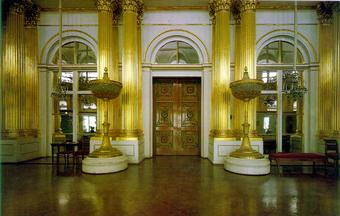 Vasily Petrovich Stasov Vasily Petrovich Stasov
(1769 - 1848)
Architect
Born July 24, 1769, in Moscow to the family of an impoverished aristocratic family. He studied at the Gymnasium at Moscow University, graduated in 1783 and entered the Council of Good Decor as an architect student. In 1794 and 1795 he served as a junior officer in the Preobrazhensky regiment, and in 1797 was assigned to the construction of salt works with the rank of collegiate secretary. Promoted to the rank of provincial secretary. Participated in arranging public festivities for the coronation of Emperor Alexander I. In 1802 was sent to France, Italy and England to complete his education. While in Rome he was accepted as a professor to the Academy of Saint Luke. In 1808 he returned to Russia and was assigned to the Chancellery of His Imperial Highness. Then he began to take part in major state and court projects. In 1811 Stasov became an academician. At that time he was an acting state councilor and architecture professor at the Academy of the Arts. In 1826 he became a member of the St. Isaac's Cathedral Building Commission.
Representative of late Classicism, Stasov's main works in Saint Petersburg include: the Provision Stores on Obvodny Canal; the Pavlovsk Barracks on the Field of Mars; the Main Court Stables; the Yamskoy Market on Razezhaya Street; the Savior-Transfiguration and Trinity-Izmailov cathedrals.
Vasily Stasov worked in Tzarskoe Selo for more than 20 years. Here he decorated entire apartments in the town of Tzarskoje Selo, and also designed interiors for the Catherine and Alexander Palaces.
By decree of Emperor Alexander I in 1817 Vasily Stasov was included in the special commission tasked with examining the palaces and determining repair priorities. Tzarskoje Selo was the most important of these palaces. Reconstruction of 1817 -1818 mainly concerned the Large(Catherine) Palace, where Vasily Stasov created many interiors which have survived to our day.
The architect hardly worked at all on the Alexander Palace during the reign of Emperor Alexander I. But during the reign of Emperor Nicholas I Vasily Stasov accomplished serious renovation projects in this palace. In1827 in place of the private chambers of Emperor Alexander I and his wife Elizabeht Alexeyevna, in the left wing of the first floor, and also in the rooms of Countess Shuvalova and her daughter, who was a lady in waiting, the architect d esigned the private suite of Emperor Alexander I, including the Study, Boudoir, Chamberlain's Room and others. Vasily Stasov was responsible for the plans and for immediate supervision of the work. Remaining archival documents signed by the architect on April 3, 1826, and entitled "Part of the Plan for the New (Alexander) Palace in Tzarskoje Selo with Indications of Conditions for the Study of His Imperial Highness (with Views of all the Apartments)" and also the watercolor by Edward Hay entitled the "Study of Nicholas I in the Alexander Palace" (1845) provide us with some idea of what these rooms were like. These interiors, which have not survived, were highly representative of the Empire style in Russia. Later they were redone for Emperor Nicholas II. esigned the private suite of Emperor Alexander I, including the Study, Boudoir, Chamberlain's Room and others. Vasily Stasov was responsible for the plans and for immediate supervision of the work. Remaining archival documents signed by the architect on April 3, 1826, and entitled "Part of the Plan for the New (Alexander) Palace in Tzarskoje Selo with Indications of Conditions for the Study of His Imperial Highness (with Views of all the Apartments)" and also the watercolor by Edward Hay entitled the "Study of Nicholas I in the Alexander Palace" (1845) provide us with some idea of what these rooms were like. These interiors, which have not survived, were highly representative of the Empire style in Russia. Later they were redone for Emperor Nicholas II.
In the landscape part of the Catherine Park the Gates for My Dear Friends (1817) were constructed according to plans by Vasily Stasov. Stasov worked on rebuilding the Chinese Village in the Alexander Park between 1817 and 1822.
|













 Culture and Art
Culture and Art  Architecture
Architecture  Architects
Architects